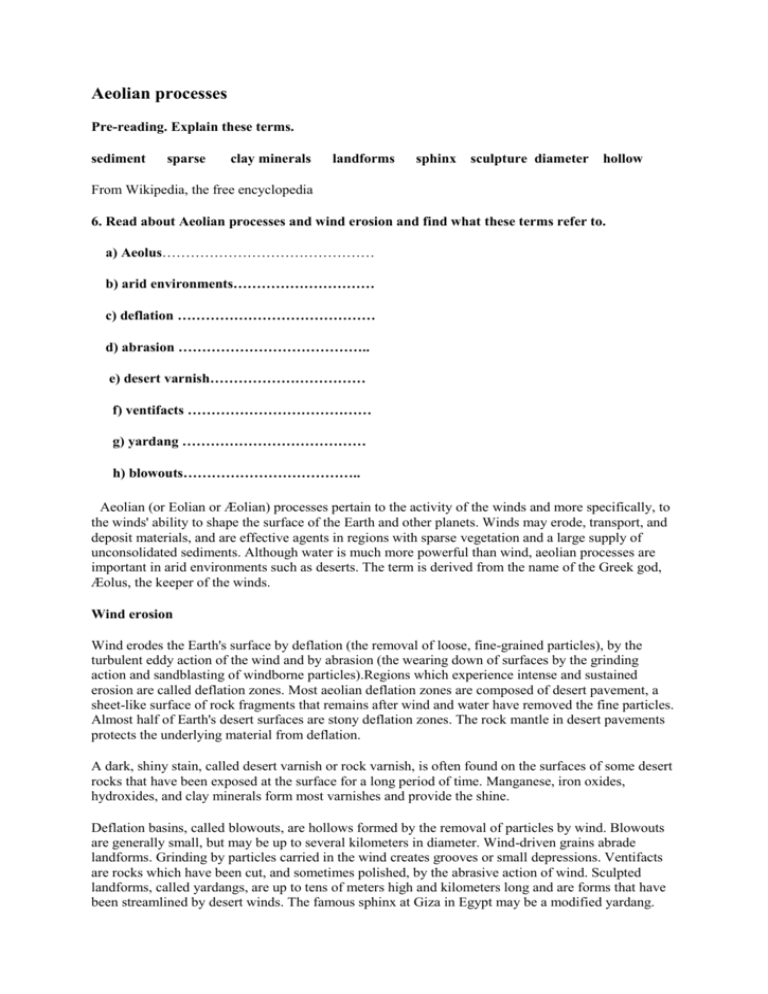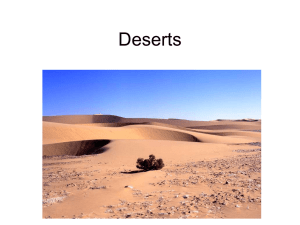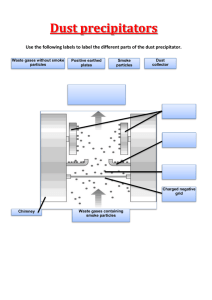Aeolian processes
advertisement

Aeolian processes Pre-reading. Explain these terms. sediment sparse clay minerals landforms sphinx sculpture diameter hollow From Wikipedia, the free encyclopedia 6. Read about Aeolian processes and wind erosion and find what these terms refer to. a) Aeolus……………………………………… b) arid environments………………………… c) deflation …………………………………… d) abrasion ………………………………….. e) desert varnish…………………………… f) ventifacts ………………………………… g) yardang ………………………………… h) blowouts……………………………….. Aeolian (or Eolian or Æolian) processes pertain to the activity of the winds and more specifically, to the winds' ability to shape the surface of the Earth and other planets. Winds may erode, transport, and deposit materials, and are effective agents in regions with sparse vegetation and a large supply of unconsolidated sediments. Although water is much more powerful than wind, aeolian processes are important in arid environments such as deserts. The term is derived from the name of the Greek god, Æolus, the keeper of the winds. Wind erosion Wind erodes the Earth's surface by deflation (the removal of loose, fine-grained particles), by the turbulent eddy action of the wind and by abrasion (the wearing down of surfaces by the grinding action and sandblasting of windborne particles).Regions which experience intense and sustained erosion are called deflation zones. Most aeolian deflation zones are composed of desert pavement, a sheet-like surface of rock fragments that remains after wind and water have removed the fine particles. Almost half of Earth's desert surfaces are stony deflation zones. The rock mantle in desert pavements protects the underlying material from deflation. A dark, shiny stain, called desert varnish or rock varnish, is often found on the surfaces of some desert rocks that have been exposed at the surface for a long period of time. Manganese, iron oxides, hydroxides, and clay minerals form most varnishes and provide the shine. Deflation basins, called blowouts, are hollows formed by the removal of particles by wind. Blowouts are generally small, but may be up to several kilometers in diameter. Wind-driven grains abrade landforms. Grinding by particles carried in the wind creates grooves or small depressions. Ventifacts are rocks which have been cut, and sometimes polished, by the abrasive action of wind. Sculpted landforms, called yardangs, are up to tens of meters high and kilometers long and are forms that have been streamlined by desert winds. The famous sphinx at Giza in Egypt may be a modified yardang. Transport 8. Fill in the missing words in this part on transport. dust storms saltating orbit haze engulf climates whirlwinds suspended globe deposit skips debris Particles are transported by winds through suspension, saltation, and creep. Small particles may be held in the atmosphere in suspension. Upward currents of air support the weight of 1…….. particles and hold them indefinitely in the surrounding air. Typical winds near Earth's surface suspend particles less than 0.2 millimeters in diameter and scatter them aloft as dust or2……….. Saltation is downwind movement of particles in a series of jumps or 3…….. Saltation normally lifts sand-size particles no more than one centimeter above the ground, and proceeds at one-half to onethird the speed of the wind. A 4………. grain may hit other grains that jump up to continue the saltation. The grain may also hit larger grains that are too heavy to hop, but that slowly creep forward as they are pushed by saltating grains. Surface creep accounts for as much as 25 percent of grain movement in a desert. Aeolian turbidity currents are better known as 5……… Air over deserts is cooled significantly when rain passes through it. This cooler and denser air sinks toward the desert surface. When it reaches the ground, the air is deflected forward and sweeps up surface 6……in its turbulence as a dust storm. Crops, people, villages, and possibly even 7…….are affected by dust storms. Some dust storms are intercontinental, a few may circle the 8……., and occasionally they may 9……. entire planets. When the Mariner 9 spacecraft entered its 10……… around Mars in 1971, a dust storm lasting one month covered the entire planet, thus delaying the task of photo-mapping the planet's surface. Most of the dust carried by dust storms is in the form of silt-size particles. Deposits of this windblown silt are known as loess. The thickest known 11…………. of loess, 335 meters, is on the Loess Plateau in China. In Europe and in the Americas, accumulations of loess are generally from 20 to 30 meters thick. Small 12…………., called dust devils, are common in arid lands and are thought to be related to very intense local heating of the air that results in instabilities of the air mass. Dust devils may be as much as one kilometer high. WORD STUDY - find the verbs which describe what happens to rocks, landforms and sediments. d-----t t--n----t e---e gr--d ab---e p----h ex---e s--p--d






